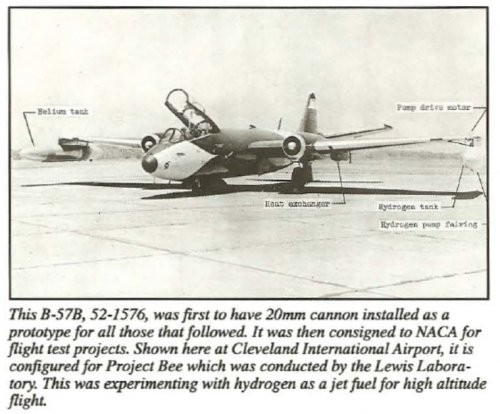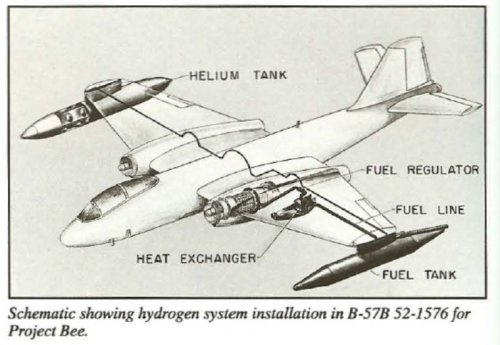- Joined
- 1 May 2007
- Messages
- 2,595
- Reaction score
- 1,965
In the back of the excellent 'From RAINBOW to GUSTO', there is a timeline
of significant events, in the RAINBOW/GUSTO, project.
One of the entries in this timeline in the very cryptic
'195612/23 First LH2 B-57 flight in Project Bee'
there is no other reference to 'Project Bee' anywhere else in the book.
I had also never come across Project Bee before.
However, perusing the books turned this up, from
'Martin B-57 Canberra: The Complete Record', Robert C.Mikesh, pp.166-167.
"Another extreme use for a B-57 was in testing liquid hydrogen
as an aircraft propulsion fuel in order to increase operating altitude.
If successful, this would allow aircraft to fly higher and out of the
range of ground-to-air missiles, the major Soviet threat at that time.
A higher flying airplane than the U-2 was the ultimate objective.
The customary JP-4 fuel for jet aircraft had an effective operating
altitude limitation around 60,000ft to 65,600ft. In simulated conditions
at Mach 0.8 when using a wind tunnel and liquid hydrogen as
a fuel, this altitude could be extended to 90,000ft, the limit of the
facility. Such prospects of extending aircraft altitudes with liquid
hydrogen became a joint effort from 1955 to 1959 between the power
plant laboratory of Wright Field and NACA. It was known as Project
Bee.
To prove the results of the wind tunnel tests in actual practice,
the NACA Lewis Laboratory at Cleveland decided to use the B57B
already on bailment to them from the Air Force. It was the J65
engine on which ground tests were being run, and this airplane
proved to be a natural. The basic plan was to equip the airplane
with a hydrogen fuel system, independent of its regular fuel system,
and modify one engine to operate on hydrogen as well as its regular fuel
. The airplane was to take off and climb on its regular fuel. After reaching
level flight at about 50,000ft, the fuel on one engine was to be switched
from JP-4 to hydrogen. When the hydrogen experiment was completed,
the fuel flow would be switched back to JP-4 and the airplane would land
under normal operating conditions.
The conversion consisted of two specially built wing tip tanks,
one for the liquid hydrogen and the other for helium
with which to pressurize the hydrogen tank to feed the engine. One
of the J65 engines was modified so that a selection could be made
to operate it on either JP-4 or the liquid hydrogen. The rest of the
system included a heat exchanger under the left wing for vaporizing
the liquid hydrogen, a flow regulator, and a manifold for feeding
gaseous hydrogen to the engine.
Both wing tip tanks were very complex. The hydrogen fuel
tank on the left wing of The airplane was 20ft 4in long with a volume
of 1.7 cubic meters. The stainless steel tank was designed for a
pressure of 3.4 atmospheres and insulated by a 2in coat of plastic
foam, covered by aluminum foil and encased in a fiberglass covering.
On the opposite wing was the helium supply tip tank containing
24 fiberglass spheres charged to 200 atmospheres.
Pilots for the experiment were William V. Gough Jr., a former
Navy pilot then working for NACA. The second pilot in the rear
seat was Joseph S. Algranti who operated the special controls of
the hydrogen fuel system. The first flight was made on 23 December
1956. Upon reaching 50,000ft over Lake Erie (for the safety of
those who would otherwise be below), the test was begun. While
making transitions from JP-4 to hydrogen, the engine responded by
overspeeding and vibrated heavily. The startled pilots quickly shut
the engine down and purged the system. A safe single engine landing
was then made back at the Cleveland airport.
The second flight was also only partially successful. Transition
from JP-4 to hydrogen was made successfully, but insufficient
hydrogen flow prevented satisfactory high-speed engine operation.
On 13 February 1957, the third, and first of three successful
flights was made and the fuel system worked well. The engine ran
for about 20 minutes on hydrogen and the pilots found that the
engine responded well to throttle changes - a very critical element.
An interesting phenomenon was that the engine burning hydrogen
produced a dense and persistent condensation trail, while the engine
operating on JP-4 left no trail. Project Bee was considered a
success whereby the feasibility of using liquid hydrogen for higher
altitude flight had been demonstrated. However, flight experiments
ended about here because requirements for such extreme altitudes
for aircraft failed to materialize."
Pictures from the same reference, page 164.
cheers,
Robin.
of significant events, in the RAINBOW/GUSTO, project.
One of the entries in this timeline in the very cryptic
'195612/23 First LH2 B-57 flight in Project Bee'
there is no other reference to 'Project Bee' anywhere else in the book.
I had also never come across Project Bee before.
However, perusing the books turned this up, from
'Martin B-57 Canberra: The Complete Record', Robert C.Mikesh, pp.166-167.
"Another extreme use for a B-57 was in testing liquid hydrogen
as an aircraft propulsion fuel in order to increase operating altitude.
If successful, this would allow aircraft to fly higher and out of the
range of ground-to-air missiles, the major Soviet threat at that time.
A higher flying airplane than the U-2 was the ultimate objective.
The customary JP-4 fuel for jet aircraft had an effective operating
altitude limitation around 60,000ft to 65,600ft. In simulated conditions
at Mach 0.8 when using a wind tunnel and liquid hydrogen as
a fuel, this altitude could be extended to 90,000ft, the limit of the
facility. Such prospects of extending aircraft altitudes with liquid
hydrogen became a joint effort from 1955 to 1959 between the power
plant laboratory of Wright Field and NACA. It was known as Project
Bee.
To prove the results of the wind tunnel tests in actual practice,
the NACA Lewis Laboratory at Cleveland decided to use the B57B
already on bailment to them from the Air Force. It was the J65
engine on which ground tests were being run, and this airplane
proved to be a natural. The basic plan was to equip the airplane
with a hydrogen fuel system, independent of its regular fuel system,
and modify one engine to operate on hydrogen as well as its regular fuel
. The airplane was to take off and climb on its regular fuel. After reaching
level flight at about 50,000ft, the fuel on one engine was to be switched
from JP-4 to hydrogen. When the hydrogen experiment was completed,
the fuel flow would be switched back to JP-4 and the airplane would land
under normal operating conditions.
The conversion consisted of two specially built wing tip tanks,
one for the liquid hydrogen and the other for helium
with which to pressurize the hydrogen tank to feed the engine. One
of the J65 engines was modified so that a selection could be made
to operate it on either JP-4 or the liquid hydrogen. The rest of the
system included a heat exchanger under the left wing for vaporizing
the liquid hydrogen, a flow regulator, and a manifold for feeding
gaseous hydrogen to the engine.
Both wing tip tanks were very complex. The hydrogen fuel
tank on the left wing of The airplane was 20ft 4in long with a volume
of 1.7 cubic meters. The stainless steel tank was designed for a
pressure of 3.4 atmospheres and insulated by a 2in coat of plastic
foam, covered by aluminum foil and encased in a fiberglass covering.
On the opposite wing was the helium supply tip tank containing
24 fiberglass spheres charged to 200 atmospheres.
Pilots for the experiment were William V. Gough Jr., a former
Navy pilot then working for NACA. The second pilot in the rear
seat was Joseph S. Algranti who operated the special controls of
the hydrogen fuel system. The first flight was made on 23 December
1956. Upon reaching 50,000ft over Lake Erie (for the safety of
those who would otherwise be below), the test was begun. While
making transitions from JP-4 to hydrogen, the engine responded by
overspeeding and vibrated heavily. The startled pilots quickly shut
the engine down and purged the system. A safe single engine landing
was then made back at the Cleveland airport.
The second flight was also only partially successful. Transition
from JP-4 to hydrogen was made successfully, but insufficient
hydrogen flow prevented satisfactory high-speed engine operation.
On 13 February 1957, the third, and first of three successful
flights was made and the fuel system worked well. The engine ran
for about 20 minutes on hydrogen and the pilots found that the
engine responded well to throttle changes - a very critical element.
An interesting phenomenon was that the engine burning hydrogen
produced a dense and persistent condensation trail, while the engine
operating on JP-4 left no trail. Project Bee was considered a
success whereby the feasibility of using liquid hydrogen for higher
altitude flight had been demonstrated. However, flight experiments
ended about here because requirements for such extreme altitudes
for aircraft failed to materialize."
Pictures from the same reference, page 164.
cheers,
Robin.


